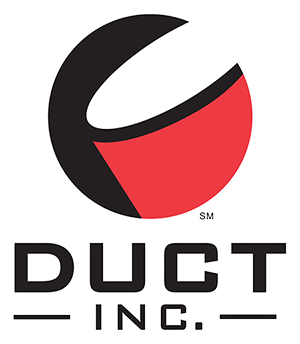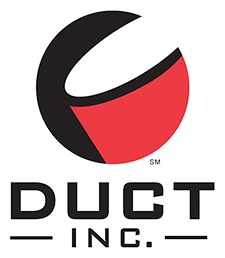Design Assistance - Technical Information
Adapting to an Existing System
There may be cases when you want to apply Duct Incorporated duct to an existing system. Duct Incorporated makes adapters for this purpose. These can be provided in flanged-to-rolled by simply requesting machine adapters that can be attached to the end of existing duct (spiral or straight) so that Duct Incorporated LaserLock™ ducting can be used.
Hints for Ordering
1. Order one clamp per Duct Incorporated component: 1 duct = 1 clamp, 2 elbows = 2 clamps
2. Specify dimensional information to speed up process:
- TRANSITIONS - A, B, D, L, X, Y
- BRANCHES - A x B x C
- IN-CUTS - A and B
- REDUCERS - All Dimensions
3. Specify end configuration required:
- Rolled • Flanged • Hose
- I.D. Connection • O.D. Connection
4. Look for 60° elbows to compliment 30° branch orders (standard is 45° branch and 45° elbows).
This is a typical application since the two components will create a perpendicular run to the trunk line.
5. Specify your needs (i.e., flange styles, hole patterns, I.D., O.D.) when applicable.
Typical parts requiring flanges will be parts that connect to filters, fans or other types of equipment.
6. How to Read the Part Number:
Example: 13003-ddcc-xyy00
| 130 | 03 | - | dd | cc | - | x | yy | 00 |
| Style Number | Diameter | Degree | CLR | Material | Gage | Special Use |
Leakage Rates
All “fit or clamp together” ducting systems allow for some degree of leakage and are not sold as airtight systems. Duct Incorporated LaserLock™ ducting offers special clamp gasket materials that may be enhanced by applying sealants to the individual rolled ends. However, the Duct Incorporated LaserLock™ ducting system is sold as a quick way of installing and modifying ductwork while retaining the usability of each component. Duct Incorporated LaserLock™ ducting is meant to be taken apart, re-assembled, stored and moved. Completely eliminating the possibility for leakage jeopardizes the inherent benefits of the duct system.
Duct Incorporated LaserLock™ ducting is designed to provide tight sealing and efficient airflow under negative pressures. The following information is provided for piping situations where fan sizing is of extreme importance. This data was obtained using standard components and was performed in accordance with SMACNA, “HVAC Air Duct Leakage Test Manual.” This chart gives the leakage rate per joint of duct at various pressures. To utilize the chart, count the number of clamps (this equals the number of joints) per size and multiply by the number given beside the corresponding diameter under the applicable pressure. These numbers assume that the product is correctly installed free of dents in the joining ends, and that the gasket is in place. Special gasket materials and sealants will increase sealing capabilities.
While Duct Incorporated is currently unaware of any method of evaluating dust collection piping alone, the following data is presented using the criteria for all duct, including HVAC. This data is presented only for the purpose of indicating acceptability of Duct Incorporated LaserLock™ ducting for dust/fume removal in negative pressure situations and should not be confused with ducting that uses tape or gaskets as sealants in the positive conveyance of air.
|
Pressures Inches
|
||||||||
|
D o P |
5"
|
7.5"
|
10"
|
15"
|
20"
|
25"
|
30"
|
|
|---|---|---|---|---|---|---|---|---|
|
3.0
|
0.8
|
1.1
|
1.3
|
1.6
|
1.9
|
2.1
|
2.4
|
|
|
4.0
|
0.8
|
1.1
|
1.3
|
1.6
|
1.9
|
2.1
|
2.4
|
|
|
5.0
|
0.8
|
1.1
|
1.3
|
1.6
|
1.9
|
2.1
|
2.4
|
|
|
6.0
|
0.8
|
1.1
|
1.3
|
1.6
|
1.9
|
2.1
|
2.4
|
|
|
7.0
|
0.8
|
1.1
|
1.3
|
1.6
|
1.9
|
2.1
|
2.4
|
|
|
8.0
|
0.8
|
1.1
|
1.3
|
1.6
|
1.9
|
2.1
|
2.4
|
|
|
9.0
|
0.8
|
1.1
|
1.3
|
1.6
|
1.9
|
2.1
|
2.4
|
|
|
10.0
|
0.8
|
1.1
|
1.3
|
1.6
|
1.9
|
2.1
|
2.4
|
|
|
12.0
|
2.2
|
3.0
|
3.6
|
4.5
|
5.8
|
6.4
|
7.5
|
|
|
14.0
|
3.2
|
4.1
|
4.5
|
5.5
|
6.5
|
7.5
|
8.5
|
|
|
16.0
|
3.2
|
4.1
|
4.5
|
6.2
|
7.0
|
8.3
|
9.0
|
|
|
18.0
|
3.2
|
4.1
|
4.5
|
6.2
|
7.0
|
8.3
|
9.0
|
|
|
20.0
|
4.3
|
5.8
|
6.3
|
7.5
|
8.5
|
10.5
|
12.0
|
|
|
22.0
|
4.3
|
5.8
|
6.3
|
7.5
|
8.5
|
10.5
|
12.0
|
|
|
24.0
|
4.6
|
6.0
|
6.3
|
7.5
|
8.5
|
10.5
|
12.0
|
|
|
Leakage Determined in Accordance with SMACNA
|
|||
|
Duct Size
|
Avg. Leakage per 100 sq. ft.
|
SMACNA
Class |
|
|
5" SP
|
10" SP
|
||
|
4" - 6"
|
13 CFM
|
20 CFM
|
5
|
|
7" - 10"
|
7 CFM
|
12 CFM
|
3
|
|
12" - 22"
|
14 CFM
|
21 CFM
|
5
|
Collapsability Strength
Duct Incorporataed ducting has been tested for strength/collapsibility. The piping was exposed to constant positive pressure and vacuum to a maximum capacity of 85” WG. None of the pipe showed signs of deformation during the test.
Installing a Cut-In or Tap-In Branch
1. Temporarily place the Cut-In or Tap-In on the main trunk in the required position, and while holding in place, mark the interior of the branch on trunk line where it is to be cut.
2. Take down Cut-In and drill a starter hole in the main trunk along the line traced from the branch. Then using metal snips or a reciprocating saw, cut out metal piece that has been traced out. File or grind any sharp edges to insure efficient flow.
3. Now use an industrial strength silicone sealant to seal between In-Cut base and main trunk.
4. Use small sheet metal screws or a banding type clamp material to secure In-Cut to the main trunk.
Painting Galvanized Components
1. Wash down all components with an industrial degreaser, insuring that no oils or residues are left behind.
2. Apply an epoxy primer in a light coating.
3. For final coat, apply an acrylic water base paint.
Caulking Used on Seams of Components
Scotch Seal® 2084 metal sealant, 3M ID #62-2084-2631-2. Ingredients: acetone, acrylonitrile, kaolin, phenolic resin, rosin ester salicyclic acid, aluminum pigment zinc oxide, amorphous silica.
Duct Incorporated Flange / Duct Specifications
Component Material
1. Components constructed of galvanized steel sheets produced by the Continuous Galvanizing process, which conforms to Lockforming Quality ASTM A-527, and Commercial Quality ASTM A-526. Galvanized sheeting is produced with a minimum spangle.
2. Components constructed of stainless steel will be 304 2B finish.
Ductwork
1. Rolled – Material sheet blanks are rolled with a single longitudinal welded seam. The ends of the duct are then formed at each end, thus producing a rolled edge on both ends of the duct, and creating a reinforcement every five feet.
2. All rolled duct joints are secured by using a clamp. Locking pins are installed to insure that clamps do not release once installed.
3. Flanged – Material sheet blanks are rolled with a single longitudinal welded seam. An angle ring flange is placed on the end of duct.
Duct Should be Supported as Follows
1. 3” – 11” diameter on 20’ centers.
2. 12” – 24” diameter on 15’ centers.
Supports should be installed to provide lateral stability to the entire piping system. Each installation is unique and should be evaluated.
Duct Diameters for Rolled and Flanged as Follows
Rolled
1. 3” – 18” available in 1” increments.
2. 18”– 24” available in 2” increments.
Flanged
1. 3” – 40” available in 1” increments
2. 42” – 60” available in 2” increments
Definitions of End Configurations
• ANGLE FLANGE: Parts indicated in catalog can be provided with a standard angle flange end. (See page 22 for angle flange hole pattern.)
• FLAT FLANGE: Parts indicated in catalog can be provided with a standard flat flange end that is either supplied blank or with a specific hole pattern provided by the customer.
• I.D. or O.D.: Parts indicated in catalog (e.g., Machine Adapters) can be provided raw without the standard rolled end. The customer must specify whether or not they want I.D. or O.D. dimensions. This would normally occur when attempting to connect Duct Incorporated ducting to an existing duct system.
• ROLLED: This is the standard end provided on the Duct Incorporated LaserLock™ ducting. These are specially machined rolled ends for added strength. The patent-pending clamp connects the rolled ends together.
• HOSE: Parts indicated in catalog can be provided with a hose connection end, when needed, to allow for easy connection to hose for areas when a hose adapter cannot be used because of space constraints.
Velocity Requirements for Typical Materials
|
Conveyed |
Velocity
FPM |
Example
|
|
Gases, Smoke, Vapor
|
1000-2000
|
All Vapors, Gases and Smoke
|
|
Fumes
|
2000-2500
|
Welding
|
|
Very Fine, Light Dust
|
2500-3000
|
Cotton Lint, Litho Powder,
Wood Flour |
|
Dry Dusts & Powders
|
3500-4000
|
Light Shavings, Rubber Dust,
Soap Dust |
|
Industrial Dust
|
3000-4000
|
Grinding/Buffing Dust,
Granite/Brick/Clay Dust |
|
Heavy Dusts
|
4000-4500
|
Heavy/Wet Sawdust, Metal Turnings,
Sand Blast Dust, Wood Blocks |
|
Heavy or Moist
|
4500+
|
Moist Cement Dust, Quick-Lime Dust,
Sticky Buffing Lint |
Rule of Thumb - Labor Guidelines
The following methods should be used for comparison and budgetary purposes only! By no means should they be used to confirm a job installation.
A + B = Man Hours
A. Straight runs and trunk lines
• Rolled duct = 15 man hours per 100’
• Flanged duct = 20 man hours per 100’
B. Machine connections
• Machine with 3 or more ports = 4 man hours per port
• Machine with 1-2 ports = 3 man hours per port
Quick method = (total number of ports) x 3 hours each = Y
Y x 2 = Ducting System Total Man Hours


